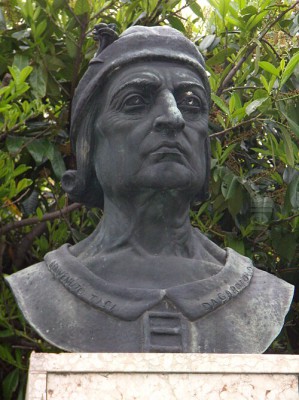
Benvenuto Tisi, more famously known as Il Garofalo, stands as a pivotal figure in the rich tapestry of Italian Renaissance art. Active primarily in Ferrara, he skillfully navigated the artistic currents of his time, blending local traditions with the groundbreaking innovations emanating from Rome and Venice. His prolific career, spanning the late 15th and first half of the 16th century, left an indelible mark on the Ferrarese school, showcasing a unique synthesis of devotional intensity and refined classicism.
Early Life and Artistic Genesis in Ferrara
Born around 1481 in Canaro, a locality then associated with Garofolo, near Ferrara, from which he derived his enduring moniker, Benvenuto Tisi's artistic journey began in a region already boasting a distinctive artistic heritage. The Ferrarese school, under the patronage of the Este dukes, had previously been shaped by formidable talents such as Cosmè Tura, Francesco del Cossa, and Ercole de' Roberti, known for their expressive intensity and often intricate, sculptural forms. It was into this environment that the young Tisi was immersed.
His initial training is traditionally attributed to Domenico Panetti, a Ferrarese painter of some local repute. While Panetti's influence might have provided a foundational understanding of regional techniques, Garofalo's inquisitive nature and ambition soon led him to seek broader artistic horizons. It is also believed that he absorbed influences from Lorenzo Costa the Elder, another significant Ferrarese master who later worked in Mantua, and possibly from Boccaccio Boccaccino, a Cremonese painter who worked in Ferrara around the turn of the century and was known for his softer, more Venetian-influenced style. These early encounters would have exposed Garofalo to a range of stylistic possibilities, from the linear precision of earlier Ferrarese art to a growing interest in atmospheric effects and richer color.
The nickname "Il Garofalo" itself is a charming testament to his practice. It translates to "the carnation," and he often incorporated this flower into his paintings, sometimes as a rebus for his name, a subtle signature that became his hallmark. This personal touch hints at an artist conscious of his identity and place within the artistic landscape.
The Roman Sojourn: Encountering the High Renaissance
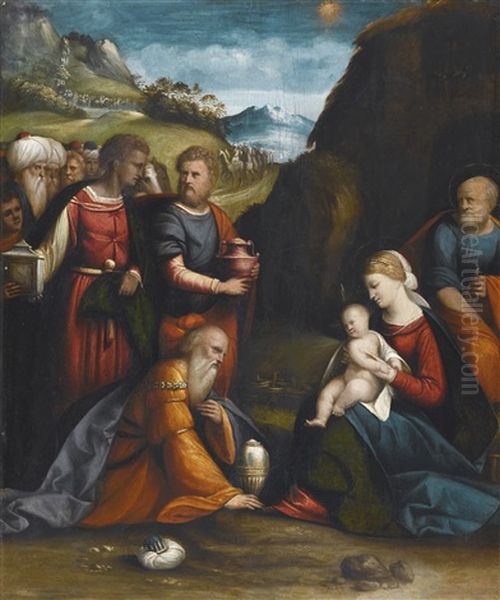
A transformative period in Garofalo's development was his time spent in Rome. While the exact dates are debated, it is generally accepted that he journeyed to the papal city at least once, likely in the early 16th century, perhaps around 1509-1512. This was a Rome pulsating with artistic fervor, dominated by the towering figures of the High Renaissance. The impact of Raphael Sanzio, then at the height of his powers and working on the Vatican Stanze, was particularly profound and lasting on Garofalo.
In Raphael's work, Garofalo encountered an ideal of grace, harmony, and compositional clarity that stood in contrast to the sometimes more agitated and angular style of his Ferrarese predecessors. The serene Madonnas, the balanced figural arrangements, and the sophisticated use of perspective in Raphael's masterpieces offered a new paradigm of artistic excellence. Garofalo absorbed these lessons deeply, and upon his return to Ferrara, he became a key conduit for introducing this Roman classicism to his native region. The influence of Michelangelo Buonarroti, whose Sistine Chapel ceiling was also underway, and the pervasive presence of classical antiquity in Rome, further broadened his artistic vocabulary.
It is also suggested that during his time in Rome, or perhaps through other travels, Garofalo may have encountered the work of Venetian masters. Some accounts mention a friendship or association with Giorgione, whose poetic and atmospheric style, characterized by soft sfumato and rich, evocative color, was revolutionizing Venetian painting. While direct evidence can be elusive, a certain warmth and sensitivity in Garofalo's later color palette might suggest an awareness of these Venetian developments.
Return to Ferrara: Ducal Patronage and Artistic Maturity
Upon returning to Ferrara, Garofalo established himself as one of the leading painters of his generation. He enjoyed the patronage of the Este court, particularly under Duke Alfonso I d'Este, a renowned connoisseur and patron of the arts who also commissioned works from Titian and Giovanni Bellini. Working for the Este court provided Garofalo with prestigious commissions and placed him at the center of Ferrarese artistic life.
During this period, he frequently collaborated with Dosso Dossi, another preeminent Ferrarese painter, and Dosso's brother, Battista Dossi. Together, they worked on various decorative schemes and altarpieces. While Dosso Dossi's style was often more fantastical and idiosyncratic, characterized by vibrant colors and imaginative landscapes, Garofalo's contributions typically leaned towards a more measured classicism, though often imbued with a gentle, lyrical quality. This collaboration highlights the dynamic artistic environment of Ferrara, where different stylistic tendencies could coexist and even complement each other.
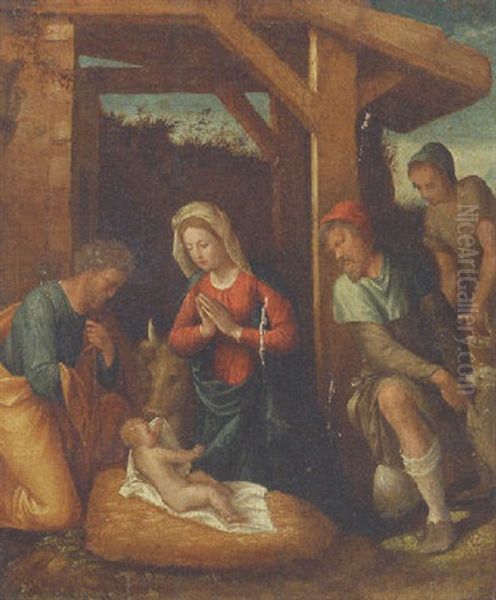
Garofalo's mature style represents a sophisticated fusion of these diverse influences. The structural clarity and idealized figural types learned from Raphael were tempered by a Ferrarese sensitivity to detail and a nuanced use of color that could, at times, echo Venetian warmth. He became highly sought after for altarpieces, devotional paintings for private patrons, and larger narrative scenes.
Signature Works and Stylistic Characteristics
Garofalo's oeuvre is extensive, covering a wide range of religious subjects. His paintings are characterized by their careful execution, balanced compositions, and often, a sweet, devotional sentiment. Figures are typically well-drawn, with graceful poses and expressive, though rarely overly dramatic, features. His landscapes, often forming the backdrop to religious scenes, are rendered with care, contributing to the overall harmony of the composition.
One of his early notable works, often cited for its complexity and ambition, is the _Massacre of the Innocents_ (c. 1519), now in the Pinacoteca Nazionale, Ferrara. This painting demonstrates his ability to handle a multi-figure composition with dramatic intensity, channeling some of the dynamism he would have observed in Rome, yet retaining a Ferrarese precision.
The _Adoration of the Magi_ (versions exist, e.g., in the Rijksmuseum, Amsterdam, and the Pinacoteca Nazionale, Ferrara) and the _Adoration of the Shepherds_ (e.g., Fitzwilliam Museum, Cambridge, dated 1507 in one version) are recurrent themes where he displayed his skill in creating serene and pious narratives. These works often feature carefully arranged figures, rich colors, and detailed settings that invite contemplation. The 2011 restoration of one version of The Adoration of the Shepherds revealed much about his technique and the painting's history.
His _Madonna and Child with Saints_ compositions are numerous and showcase his debt to Raphael in their harmonious groupings and idealized figures. An example is the Madonna and Child Enthroned with Saints William of Aquitaine, Clare, Anthony of Padua and Francis (c. 1517-1518) in the National Gallery, London, which displays a classical balance and serene dignity. Another, the Madonna and Child with Saints John the Baptist and Jerome (Pinacoteca di Brera, Milan), exemplifies his ability to create intimate devotional images.
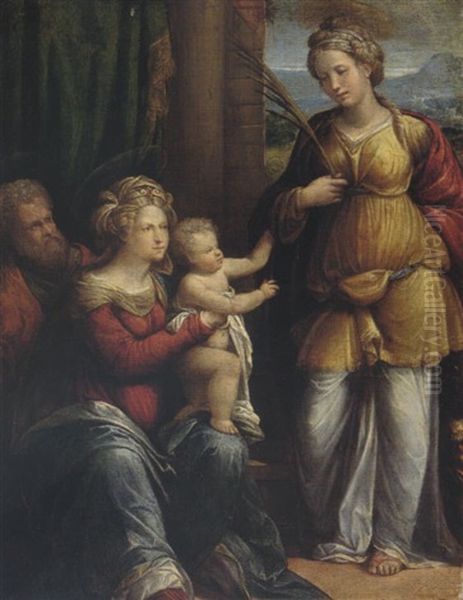
A particularly grand and complex work is _The Wedding at Cana_ (c. 1531), originally painted for the refectory of the convent of San Bernardino in Ferrara and now housed in the Borghese Gallery, Rome (though some sources indicate the Hermitage Museum holds a significant version). This large-scale painting is a testament to his mastery of narrative, his ability to organize numerous figures within a coherent architectural space, and his rich use of color.
Other significant works include the _Betrayal of Christ_, the _Resurrection of Christ_ (e.g., Capitoline Museums, Rome, c. 1520), which shows a powerful, dynamic Christ figure, and the _Allegory of the Old and New Testaments_ (versions exist, one notably in the Hermitage Museum), a complex iconographical piece demonstrating his intellectual engagement with theological themes. The _Meditation of Saint Jerome_ (Staatliche Museen, Berlin) and _Saint Nicholas of Tolentino Reviving the Birds_ (c. 1530, Metropolitan Museum of Art, New York) further illustrate the breadth of his religious iconography and his consistent, polished style.
His works often feature a distinctive palette, which, while capable of richness, tends towards clarity and harmonious combinations. The influence of Giulio Romano, Raphael's principal pupil and a key figure in the transition to Mannerism, can also be discerned in some of Garofalo's later works, particularly in a certain robustness of form and complexity of composition.
Later Years, Blindness, and Unwavering Faith
A significant and poignant event in Garofalo's later life was the loss of his eyesight. Around 1550, he became blind, a devastating blow for any painter. Despite this immense challenge, his devotion to his art and his faith reportedly remained steadfast. According to Giorgio Vasari, the 16th-century biographer of artists, Garofalo continued to "paint" or at least remain active in a creative capacity, possibly by overseeing his workshop or through sheer willpower, for some years even after losing his sight. He spent his final years in the convent of San Bernardino in Ferrara, a testament to his deep piety.
Vasari also notes that Garofalo married at the age of forty (around 1521) and had two children. His personal life, though not extensively documented, seems to have been grounded in his community and his faith. He passed away on September 6, 1559, at the age of approximately 78, not 48 as some older or mistranslated sources might suggest. His death marked the end of an era for Ferrarese painting.
Artistic Relationships and the Ferrarese Milieu
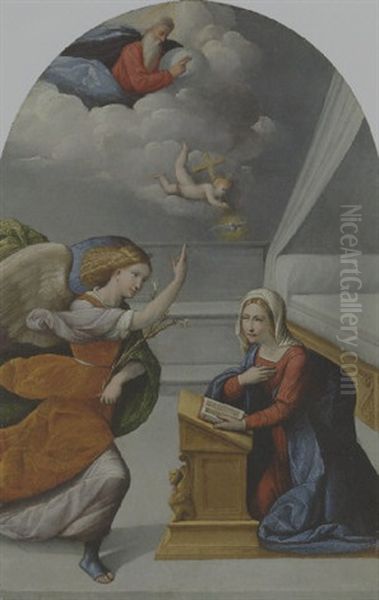
Garofalo's career was interwoven with the artistic fabric of Ferrara and beyond. His collaborations with Dosso and Battista Dossi were central to many Este court projects. The presence of Titian at the Ferrarese court, working on Alfonso I's famed Camerini d'Alabastro (Alabaster Chambers), meant that Garofalo was contemporary with one of the giants of Venetian painting. While direct collaborative evidence between Garofalo and Titian on a specific piece like a "Peter Martyr" is not as firmly established as Titian's own famous versions of that subject, their paths undoubtedly crossed, and the vibrant artistic exchanges at court would have been mutually influential.
The broader Italian Renaissance context included figures like Leonardo da Vinci, whose sfumato techniques were transforming painting; Perugino, Raphael's master, whose gentle style had a wide impact; and Fra Bartolommeo, a leading painter of the High Renaissance in Florence. While Garofalo's primary influence was Raphael, the artistic innovations of these and other masters contributed to the overall climate in which he worked.
His relationship with his patrons, especially the Este family, was crucial, providing him with the means and opportunities to create significant works. The Este court was a hub of culture, attracting poets like Ludovico Ariosto, and Garofalo's art contributed to its splendor.
Legacy and Influence
Benvenuto Tisi da Garofalo played a crucial role in the evolution of the Ferrarese school. He successfully integrated the classical ideals of the Roman High Renaissance, particularly the Raphaelesque style, into the local artistic tradition. This synthesis resulted in a style that was both elegant and accessible, appealing to both courtly patrons and religious institutions.
He had a number of pupils and followers who continued to work in a style influenced by him. Girolamo da Carpi is perhaps the most notable artist who spent time in his workshop and absorbed elements of his classicizing manner, though Carpi also developed his own distinct style, influenced by Correggio and Parmigianino. Garofalo's influence extended through the mid-16th century in Ferrara, and his works were admired and collected.
Later Ferrarese painters, such as Scarsellino (Ippolito Scarsella), who worked in the late 16th and early 17th centuries, looked back to the achievements of Garofalo and Dosso Dossi as foundational figures of their local school, even as they responded to newer artistic trends like Mannerism and the early Baroque.
Conclusion: A Harmonious Vision
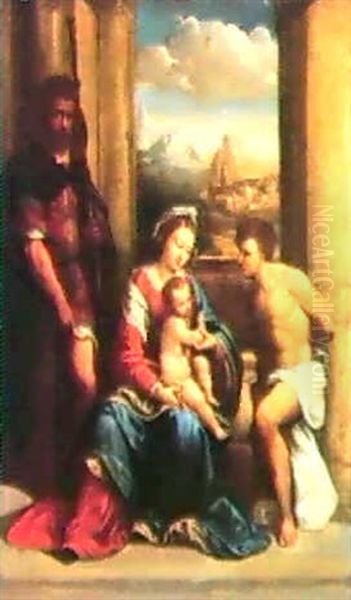
Benvenuto Tisi da Garofalo remains a significant, if sometimes overlooked, master of the Italian Renaissance. His ability to absorb and reinterpret the monumental classicism of Raphael, while retaining a personal touch and a connection to his Ferrarese roots, marks him as a distinctive voice. His prolific output, characterized by technical skill, harmonious compositions, and a sincere devotional spirit, ensured his prominence in his own time and secured his place in the history of art. From his early training in the vibrant artistic milieu of Ferrara to his transformative experiences in Rome and his long, productive career at the Este court, Garofalo crafted a legacy of beauty and piety that continues to resonate. His carnation signature remains a quiet reminder of an artist who skillfully blended tradition and innovation, leaving behind a body of work that enriches our understanding of the Ferrarese Renaissance.